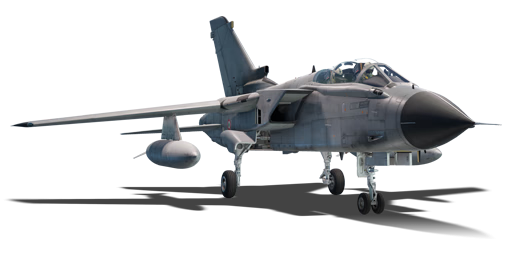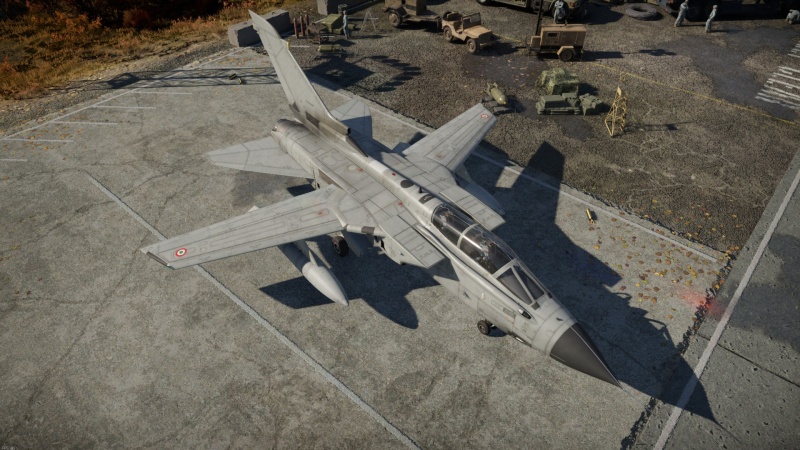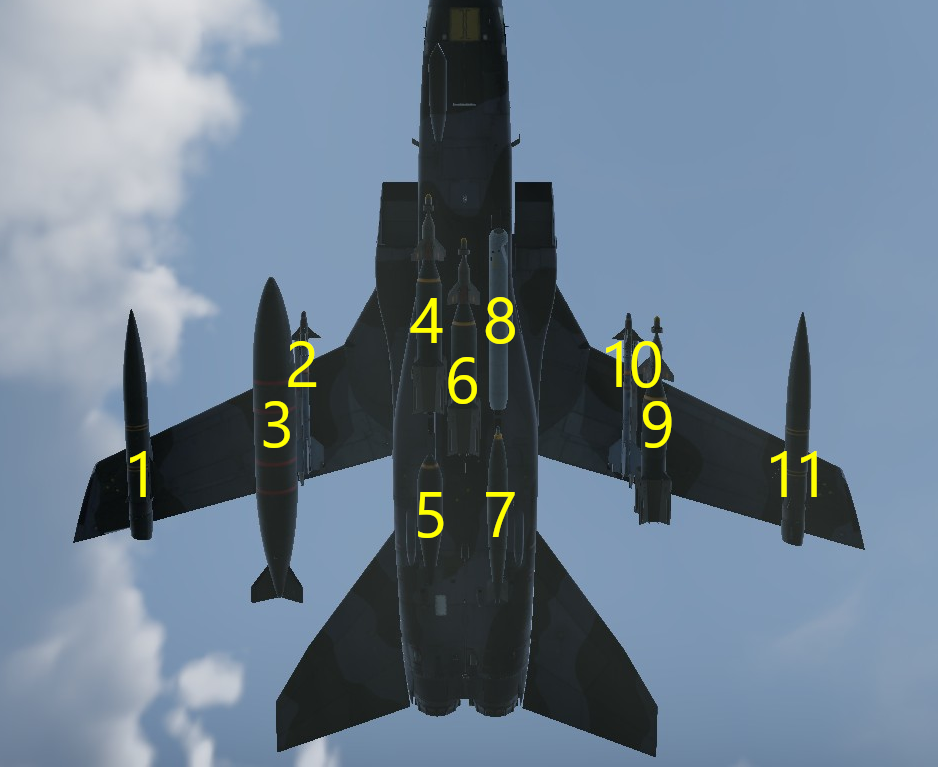Difference between revisions of "Tornado IDS (1995) (Italy)"
Isaac_Victor (talk | contribs) m (→See also: I added the list with links to other aircraft with variable geometry wings that exist in the game) (Tag: Visual edit) |
(→Suspended armament) |
||
| Line 168: | Line 168: | ||
! Large calibre countermeasures | ! Large calibre countermeasures | ||
| 28 || || || || || || || || || || 28 | | 28 || || || || || || || || || || 28 | ||
| + | |- | ||
| + | ! Large calibre chaff | ||
| + | | 340 || || || || || || || || || || 340 | ||
|- | |- | ||
! CLDP targeting pod | ! CLDP targeting pod | ||
| Line 183: | Line 186: | ||
* 2 x 1,500 l drop tanks | * 2 x 1,500 l drop tanks | ||
| − | * 56 x large calibre countermeasures | + | * 56 x large calibre countermeasures + 680 x large calibre chaff |
* 2 x AIM-9L Sidewinder missiles | * 2 x AIM-9L Sidewinder missiles | ||
* 4 x 1,000 lb LDGP Mk 83 bombs (4,000 lb total) | * 4 x 1,000 lb LDGP Mk 83 bombs (4,000 lb total) | ||
Latest revision as of 08:11, 23 August 2024
| This page is about the strike aircraft Tornado IDS (1995) (Italy). For other versions, see Tornado (Family). |
Contents
Description
The Panavia Tornado is a two-seat, twin-engine, swing-wing, multi-role combat aircraft built jointly by Germany, the United Kingdom, and Italy. This version is the Tornado Interdiction/Strike or IDS, and was intended as a low-flying fighter bomber armed with precision weapons.
Introduced in Update "Apex Predators" this Italian Tornado is similar to other Tornados in other nations, only really differing in the skin, markings and targeting pod. The Tornado can be an effective air support provider, mainly thanks to having access to a wide array of armaments which include guided and unguided bombs. However, it does lack somewhat in the air-to-air department.
General info
Flight performance
| Characteristics | Max speed (km/h at 10,972 m) |
Max altitude (metres) |
Turn time (seconds) |
Rate of climb (metres/second) |
Take-off run (metres) | |||
|---|---|---|---|---|---|---|---|---|
| AB | RB | AB | RB | AB | RB | |||
| Stock | 1,993 | 1,989 | 12800 | 31.4 | 31.5 | 154.1 | 151.8 | 800 |
| Upgraded | 2,038 | 2,005 | 30.6 | 31.0 | 203.3 | 177.0 | ||
Details
| Features | |||||
|---|---|---|---|---|---|
| Combat flaps | Take-off flaps | Landing flaps | Air brakes | Arrestor gear | Drogue chute |
| ✓ | ✓ | ✓ | ✓ | ✓ | X |
| Limits | Wings (km/h) | Gear (km/h) | Flaps (km/h) | Max Static G | |||
|---|---|---|---|---|---|---|---|
| Combat | Take-off | Landing | + | - | |||
| Min sweep | 972 | 520 | 972 | 552 | 440 | ~__ | ~__ |
| Max sweep | 1,555 | - | - | - | ~__ | ~__ | |
| Optimal velocities (km/h) | |||
|---|---|---|---|
| Ailerons | Rudder | Elevators | Radiator |
| < 670 | < 650 | < 700 | N/A |
Engine performance
| Engine | Aircraft mass | |||||||
|---|---|---|---|---|---|---|---|---|
| Engine name | Number | Basic mass | Wing loading (full fuel) | |||||
| Turbo-Union RB199-34R Mk.103 | 2 | 14,299 kg | ___ kg/m2 | |||||
| Engine characteristics | Mass with fuel (no weapons load) | Max Gross Weight | ||||||
| Weight (each) | Type | 16m fuel | 20m fuel | 30m fuel | 45m fuel | 56m fuel | ||
| 968 kg | Afterburning low-bypass turbofan | 15,826 kg | 16,113 kg | 17,019 kg | 18,379 kg | 19,389 kg | 25,900 kg | |
| Maximum engine thrust @ 0 m (RB/SB) | Thrust to weight ratio @ 0 m (WEP) | |||||||
| Condition | 100% | WEP | 16m fuel | 20m fuel | 30m fuel | 45m fuel | 56m fuel | MGW |
| Stationary | 3,777 kgf | 7,293 kgf | 0.92 | 0.91 | 0.86 | 0.79 | 0.75 | 0.56 |
| Optimal | 4,192 kgf (1,400 km/h) |
8,155 kgf (1,400 km/h) |
1.03 | 1.01 | 0.96 | 0.89 | 0.84 | 0.63 |
Survivability and armour
The Tornado has no armour to speak of and is relatively large, making it an easy target for enemy guns. Almost any hit to the center part of the Tornado will leave its speed crippled, while any hit to the wings and tail will most likely cripple flight performance, if not disabling the aircraft outright. Although it could in theory make its way back to base even with only one engine, any enemy attention during this timespan will most likely get you sent back to the hangar. It also has 2 pilots, which means that you can continue flying in the unlikely case that only 1 pilot is knocked out.
Modifications and economy
Armaments
| Ballistic Computer | ||||
|---|---|---|---|---|
| CCIP (Guns) | CCIP (Rockets) | CCIP (Bombs) | CCRP (Bombs) | Lead indicator |
| |
|
|
|
|
Offensive armament
The Tornado IDS (1995) (Italy) is armed with:
- 2 x 27 mm Mauser BK27 cannons, chin-mounted (180 rpg = 360 total)
Suspended armament
The Tornado IDS (1995) (Italy) can be outfitted with the following ordnance:
| 1 | 2 | 3 | 4 | 5 | 6 | 7 | 8 | 9 | 10 | 11 | ||
|---|---|---|---|---|---|---|---|---|---|---|---|---|
| 1,000 lb LDGP Mk 83 bombs | 1, 2 | 1, 2‡ | 1, 2‡ * | 1*‡ | 1, 2‡ | 1, 2‡ | 1, 2 | |||||
| 1,000 lb Mk 83 AIR bombs | 1, 2 | 1, 2‡ | 1, 2‡ * | 1*‡ | 1, 2‡ | 1, 2‡ | 1, 2 | |||||
| 1,092 lb GBU-16 Paveway II bombs | 1† | 1*† | 1†‡ | 1† | ||||||||
| 2,000 lb GBU-24 Paveway III bombs | 1*†‡ | |||||||||||
| AIM-9L Sidewinder missiles | 1 | 1 | ||||||||||
| Large calibre countermeasures | 28 | 28 | ||||||||||
| Large calibre chaff | 340 | 340 | ||||||||||
| CLDP targeting pod | 1† | |||||||||||
| 1,500 l drop tanks | 1 | 1 | ||||||||||
| * Guided bombs on hardpoint 4 cannot be equipped with 1,000 lb bombs on hardpoints 5-6 † CLDP targeting pod must be equipped when using guided bombs ‡ Bombs on hardpoint 6 cannot be equipped with dual bomb mounts on hardpoints 4-8 or GBU-24 on hardpoint 4 | ||||||||||||
| Default weapon presets | |
|---|---|
| |
Usage in battles
There are multiple ways to use the Tornado in ARB, one tactic is to stick to the team and try and give support with your AIM-9Ls on your way to the enemy bases and/or ground targets. This gives you the advantage of team cover and a bit of safety, although you will undoubtedly be in the midst of battle once enemy interceptors and fighters reach your team. The other tactic would be to go full throttle directly to the enemy bases while keeping extremely low to the ground to decrease your chances of being spotted visually or by radar. While this leaves you mostly alone and isolated from the possible support of your team, you will be able to take a more direct route to your main target, meaning you'll be able to evade any slower or unsuspecting enemies. Taking an active role in air-to-air combat is not advised, as the Tornado's flight performance is not suited to it and you'll most likely be shot down very quickly. So keep in mind that although the Tornado is fast, its not very manoeuvrable at high speed so try to avoid faster enemies such as the F-16 or the F-14. In the case of 1-to-1 confrontation the best option is to simply hope you are faster and run away, against capable fighters like the MiG-23, F-16, MiG-29, Viggen, F-14, and Mirage 2000 you don't stand a chance, unless the enemy pilot is extremely inexperienced. With countermeasures you are able to survive for longer if you can time their use and can dodge without losing too much of your speed. In GRB you can easily pick off enemy SPAA once you have unlocked your laser guided bombs, so try to fly as high as possible. If you only have dumb bombs you're going to need to stick to the ground as much as possible to avoid enemy AA, you can't linger too much on the battlefield or else the enemy team will begin to prioritise you as a target. You also need to be very weary of what type of enemy air has been spawned in, if you focus too much on ground vehicles you become easy pickings for any enemy aircraft which can take advantage of you not realising they're there. In conclusion, play a reserved role and only engage when you think its clear.
Pros and cons
Pros:
- Variable sweep wing and good controllability in landing and takeoff
- Large payload of almost 3 tons in effective TNT with dumb bombs
- Has a good amount of GBU-16 and GBU-24 laser guided bombs, very effective in close air support and reliable against advanced enemy SPAAs
- Supersonic
- As it has the same targeting pod of the Mirage 2000D, the quality of thermal view and zoom is significantly better than the targeting pod of ASSTA1 and Gr 1, being easier to spot enemy tanks
- Very effective and advanced in simulator battles in any close air support or bombing scenario, thanks to the excellent HUD, complete Ballistic Computer and great cockpit
Cons:
- Terrible in air-to-air combat, heavy airframe, big and slow vs any contemporaries and also only having 2 AIM-9Ls for self defence
- High fuel consumption
- Bombs severely limit its maximum speed to about Mach 1.05
- No search radar
- The wing rips pretty easily under any high G stress and with a combat load, and mainly in manual wing sweep control
History
The Panavia Tornado was born out of a joint effort by Italy, Germany and the United Kingdom during the late cold war in the 1970's. The Tornado would be designed as a twin-engined, variable-swept wing aircraft with a two-person crew an internal gun and provisions for a wide array of armament which included guided/unguided bombs, mine launchers, rockets, air to air missiles and air to ground missiles. The aircraft was also armed with 2 German made 27mm Mauser BK-27 revolver cannon which was able to make short work of pretty much any aircraft it had in its sights, with the right munition it was also capable of taking out lightly armoured vehicles such as the BMP-1. The Panavia Tornado was primarily made to undertake missions which included tactical strike, reconnaissance, air defence and maritime patrol. What they aimed when making the design was an aircraft which could be very multi-role, ot would allow the Panavia Tornado to replace several different types of aircraft which were at the time in service with the respected countries. The main variants which were designed included the IDS which was mainly a strike-fighter, the ADV which was the Air Defence Variant and lastly the ECR, which was mainly created to carry out recon and SEAD missions. In terms speed the Tornado could go up to 2,400 km per hour, its engine being known as the Turbo-Union RB199-34R Mk.103. After several proposals and design changes, the first prototype of the Panavia Tornado would fly on the 14th of August, 1974. The prototype would further solidify the partnership as when it was being demonstrated, a lot of positive comments would be made. Thus development would continue smoothly with the first aircraft being officially delivered to the RAF (Royal Air Force) and the German Air Force on 5 and 6 June 1979 respectively.
Italy on the other hand would get their hands on the Panavia Tornado a couple years later on the 25th September, 1981. It wouldn't take long before it would actually begin to face actual combat missions, although it wouldn't be facing any Warsaw Pact enemies as previously envisioned. Its first combat missions would happen during the second Gulf War by the British, Italian and Saudi Arabian air forces. This would be later followed by missions in the Yugoslavian and Kosovo wars. In terms of service within the Italian air force, Italian Tornados would be the first aircraft that Italy actually fully used in full scale combat since the end of WW2.
Their more famous usage would be during Operazione Locusta, and would also be the first time since the end of WW2 that an Italian Air Force fighter would be shot down. During Operazione Locusta (the code name given to the contribution of the Italian Air Force during the Gulf War) Italian Tornados would be sent to Kuwait in 1990 by the Italian Government. In total 8 Panavia Tornados in the IDS variant would be sent. These Tornados would be from the 6º, 36º and 50º Stormo, their mission was to fly into Iraq from Kuwait and drop bombs unto Iraqi controlled territory. The Tornado squadron would form the ''Autonomous Flight Department of the Italian Air Force in the Arabian Peninsula''. During the time they were deployed the Italian airforce would rack up to 589 flight hours and would complete 226 sorties into Iraqi airspace in just 42 days of war. After the war they'd return to Italy and be used in other conflicts, the Italian air force Tornados are still in service as of 2023, mainly thanks to several different extensive upgrade programs which extended the life of those aircraft up to 2035, where they will likely be replaced by the F-35.
Media
- Skins
See also
- Other jet planes with variable sweep wings
External links
Paste links to sources and external resources, such as:
- https://forum.warthunder.com/index.php?/topic/485805-panavia-tornado/
- https://www.aircraftrecognitionguide.com/panavia-tornado
| Panavia Aircraft GmbH | |
|---|---|
| Strike Aircraft | Tornado (Family) |
| Germany | ◄Tornado IDS WTD61 · ◄Tornado IDS ASSTA1 · ◄Tornado IDS MFG |
| UK | Tornado GR.1 · Tornado GR.4 · Tornado F.3 · Tornado F.3 Late |
| Italy | Tornado ADV · ▄Tornado IDS · ▄Tornado IDS (1995) |
| Italy jet aircraft | |
|---|---|
| Aerfer | Sagittario 2 · Ariete |
| Fiat | G.91 pre-serie · G.91 R/1 · G.91 R/4 (Portugal) · G.91 Y · G.91 YS |
| AMX International | AMX · AMX A-1A (Brazil) |
| Panavia | Tornado ADV · ▄Tornado IDS · ▄Tornado IDS (1995) |
| Foreign: | |
| Vampire | Vampire FB 52A |
| F-84 | ▄F-84F · ▄F-84G-21-RE |
| F-86 | CL-13 Mk.4 · ▄F-86K |
| F-104 | ▄F-104G · F-104S · ▄F-104S TAF (Turkey) · F-104S.ASA |
| F-16 | ▄F-16A ADF |
| AV-8 | ▄AV-8B Plus |
| Hungary | |
| Mikoyan-Gurevich | ◔MiG-15bis · ◔MiG-17PF · ◔MiG-21MF · ◔MiG-21bis-SAU · ◔MiG-23MF · ◔MiG-29 |
| Ilyushin | ◔IL-28 |
| Sukhoi | ◔Su-22M3 |
| Saab | ◔JAS39EBS HU C |






